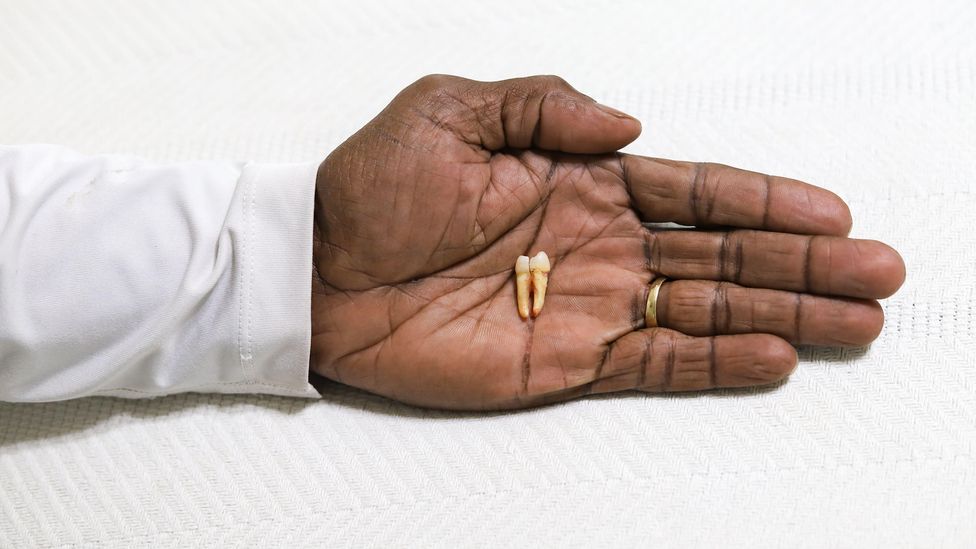
The silent danger of deep gum disease, why you need to know
- Published By Jane Njeri For The Statesman Digital
- 3 years ago
Crowded, misaligned and riddled with cavities and inflamed gums, our teeth are infamous for their flaws. The modern human is unique in the level of painstaking, daily intervention we need to make sure our teeth and gums don't become diseased.
Far from being confined to toothache and sore gums, our oral health affects everything from our diet to our overall wellbeing and risk of death of any cause in a given year.
This is because diseases of the mouth don't always stay in the mouth. A close link is emerging between oral health and some of the world's most pressing diseases, including cardiovascular disease, diabetes and Alzheimer's, underscoring the mouth's role as a mirror of health and disease, and a sentinel for our overall wellbeing.
Unfortunately, perhaps the most telling feature of oral health is the most frequently ignored. Periodontitis or deep gum disease, the second most widespread oral disease after cavities, affects more than 47% of adults over the age of 30. By the age of 65 and older, 64% have either moderate or severe periodontitis. Globally, it is the 11th most common disease in the world.
The long-term presence of disease-causing bacteria in the gums and the bloodstream shapes our health well beyond the mouth
Periodontitis is an infection not in the surface gum that you can see when you grin, but deep below the surface. After an initial phase of superficial inflammation in the visible part of the gum (gingivitis), bacteria move down below the gumline into pockets by the tooth root where they erode the structures that hold the tooth in place. Because of the hidden nature of periodontitis, many people who have it don't know it's there until its very advanced stages. The disease has a genetic component, and is also influenced by oral hygiene.
For most, the disease doesn't become noticeable until your 40s or 50s, says Sim K Singhrao, senior research fellow in the school of dentistry at the University of Central Lancashire in the UK. By this time, severe damage may already have undermined the tooth's architecture, risking tooth loss. Meanwhile, the infection has sent a steady drip of bacteria, such as Treponema denticola and Porphyromonas gingivalis, around the bloodstream for decades.
It is this long-term presence of disease-causing bacteria in the gums and the bloodstream that shapes our health well beyond the mouth.

Part of the danger of periodontitis is that it goes undetected in many patients, as it commonly presents with no symptoms (Credit: Getty Images)
"If you imagine the bloodstream as a bus, it will take passengers on – things like bacteria in the mouth – and it will go everywhere around the body," says Singhrao. "Some will get off in the brain, some in the arteries, some in the pancreas or the liver."
Where there are vulnerabilities in these organs, or when microbes aren't effectively cleared away, they cause inflammation and start or exacerbate other inflammatory diseases.
Indeed, periodontitis is linked to a roll call of some of the most widespread non-communicable diseases in the world: cardiovascular disease, diabetes, Alzheimer's, obesity, a range of cancers, rheumatoid arthritis, Parkinson's, pneumonia and complications in pregnancy.
For many of these conditions, it is a two-way relationship. For instance, periodontitis may worsen conditions such as atherosclerosis, the hardening of the artery walls, and the presence of atherosclerosis also predisposes patients to periodontitis. There have been no randomised controlled trials (RCT), considered the gold standard of medical investigation, delving into this relationship (these would be hard to carry out ethically, denying one group treatment of their periodontitis for a prolonged period to see how it affected their atherosclerosis). However, periodontitis-causing bacteria usually found only in the mouth have been discovered embedded in atherosclerotic plaques.
Of all these chronic health conditions, diabetes has the strongest two-way link with periodontitis. People with type 2 diabetes have a three-fold greater risk of developing periodontitis than people without. For people who have type 2 diabetes and periodontitis, the infection worsens their body's ability to control blood sugar levels.
But what's behind this link?

Periodontitis has a genetic element, but risk of developing the disease can be minimised by meticulous oral hygiene (Credit: Getty Images)
It comes back to the steady flow of bacteria from pockets deep in the gums into the bloodstream. Where the immune system detects bacteria or other pathogens, immune cells release a barrage of cellular messaging molecules known as inflammatory markers. These inflammatory markers aid the immune system in attacking and killing invading pathogens. The swelling and redness that appears within moments around a wound is the result of this efficient inflammatory response. In the short term, inflammatory markers act as excellent guides for the immune system to the site of likely infection. But when these sentinels linger in the body, they cause a host of problems.
The majority of the conditions linked to periodontitis have a well-established inflammatory element. For instance, nearly 30 years ago, an inflammatory marker called tumour necrosis factor-alpha was revealed to increase insulin resistance in diabetics. This was shortly followed by the discovery of a wave of other inflammatory markers that exacerbate both obesity and type 2 diabetes. This dense network of inflammatory markers has led to research aiming to treat diabetes by subduing chronic inflammation.
But the constant drip of bacteria from an infection hidden in the gums does precisely the opposite.
"All inflammatory diseases are connected, they have an influence on each other," says Palle Holmstrup, professor emeritus in the department of odontology at the University of Copenhagen. "Periodontitis is one of the most common, if not the most common, inflammatory disease of the human body.
"It's the same inflammatory mediators that are active in several types of inflammatory diseases – rheumatoid arthritis, heart disease, diabetes and so on. If you have periodontitis, you will have an increased level of systemic low-grade inflammation."
In humans, it's hard to investigate directly how treating periodontitis could alleviate conditions like diabetes, for the same ethical reasons as with atherosclerosis: you can't deny a patient treatment of their disease, particularly if you suspect it could worsen their other conditions. It makes studying this complex knot of connected inflammatory diseases especially difficult, and causal relationships hard to pin down.
It is very easy to lower your risk of getting periodontitis, or to treat it to reduce inflammation if you already have it
Holmstrup's group has, however, measured the effect of periodontitis on diabetes in rats. His group investigated the difference in blood sugar response to diabetic rats who were given a periodontitis-like condition, and diabetic rats without. Periodontitis led to a 30% greater spike in blood sugar after a meal.

Left unchecked periodontitis can lead to tooth loss, which comes with its own collection of health risks (Credit: Alamy)
The ultimate conclusion of periodontitis, if aggressive and untreated, is tooth loss. On top of decades of chronic inflammation, tooth loss comes with a new set of health risks, including cognitive decline and dementia.
Bei Wu, dean's professor in global health at New York University's Rory Meyers College of Nursing, discovered a dose-dependent relationship: the more teeth you lose, the greater your risk of cognitive decline and dementia. In the largest study of its kind, Wu studied the health data of 34,000 patients in the US to find that for every tooth someone loses, they have a 1.4% increase in risk of cognitive impairment and 1.1% heightened risk of dementia. Overall, those who had lost teeth had a 48% raised risk of cognitive impairment and a 28% raised risk of dementia, compared with similar individuals who had all their teeth.
Tooth loss has been largely overlooked as a risk factor for dementia, and Wu says she is usually greeted with surprise when she points out the relationship between the two. "Oral health is a missing piece," says Wu. "We're trying to provide the evidence to show it should be part of the equation."
While periodontitis may be a common cause of tooth loss, there may be other culprits for these effects besides inflammation. So far Wu's tooth-loss studies have only investigated correlations and not causation, but she wants to investigate the role of nutrition in this relationship, among other factors.
"A good denture could improve nutrition intake and also your mastication [chewing]," says Wu. "That can potentially increase blood flow, which might have an impact on cognitive function – but this is still just a hypothesis."

Every time we brush our teeth we have an opportunity to improve our wider systemic health too (Credit: Alamy)
The emerging links between our oral health and this host of other conditions has a very significant upshot: it is easy to lower your risk of getting periodontitis, and to treat it effectively if you already have it.
"If we brush our teeth properly and have good oral hygiene, then potentially we can prevent the onset of periodontitis," says Wu.
If the disease does set in, then in the early stages it can be treated with scaling and root planing, which scrapes microbes off the lower tooth surface above and just below the gum line. If you have serious periodontitis, the solution may include surgical treatment, "which means you loosen the soft tissue of the gums and clean the root surfaces, and put the tissue back", says Holmstrup.
The problem is detection, due to the disease's often symptomless nature coupled with the common misconception that unless you have severe tooth pain, you don't need to go to the dentist. The solution there is again simple: if you're due an appointment, don't delay.
Share on
SHARE YOUR COMMENT
MORE STORIES FOR YOU
Trending Stories
DJ Mo’s former illicit lo...
- Published By Jane
- January 15, 2024
Mapenzi! Zari and Tanasha...
- Published By Jane
- October 24, 2023
Zuchu Speaks on Diamond P...
- Published By Jane
- October 12, 2023
Hio Ni Upumbavu Wasituche...
- Published By Jane
- November 8, 2023
RECOMMENDED FOR YOU
How People are Using AI t...
- Published By The
- October 29, 2025
How Raila Odinga’s Death...
- Published By The
- October 29, 2025
What is Ayurveda? Raila O...
- Published By The
- October 29, 2025
Why Parents Should Spend...
- Published By The
- October 29, 2025
Latest Stories
Why Governor Jonathan Bii...
- Published By The
- November 11, 2025
Justina Wamae: Election W...
- Published By The
- November 11, 2025
The Final Journey: Detail...
- Published By The
- November 11, 2025
Woman Delivers Quadruplet...
- Published By Jedida
- November 11, 2025



